Farm Stay, Shillimb
A deep seated love for the outdoors and the off-grid concept of tiny houses lead our client Manik to launch a farm stay, near Pune. The idea was to help people disconnect from the nine-to-five mentality and live more balanced lives. Something that forces them to take stock of what is important, away from tech and urban distractions. Like an antidote to modern life.
The farm is located in Shillimb village near Pawna Lake. They have tiny cabins with tiny carbon footprints. For landscape designing they were looking a sustainable, holistic lifestyle where people work with nature instead of against it- an approach that integrates land, resources, people & the environment through mutually beneficial synergies, just like an actual forest. And that's how our client Manik encountered the world of Permaculture. The approach aligned seamlessly with their dream behind their sustainably built, self-sufficient and off-grid cabins- something that would allow them to make their land more beautiful, abundant & forgiving- eliminating most of the backbreaking work that's needed to maintain the typical lawn & garden.
We started with marking contours and stabilizing the slopes. We included food forest, wild zone, butterfly garden, live fence, wind & fire break, avenue, papaya & banana circle for grey water harvesting, pond, vegetable garden, herbal garden, and a food garden for each cabins. And being amid the mountain ranges, a view tower is a must to enjoy the all season view. We carefully selecting multi-functional & native trees that is best suited to the land- providing a biodiverse habitat for beneficial insects and birds. There was a high tension power line passing across their farm near the entrance, where we planted a beautiful patch of flowering bushes, that one must now see them flourishing! It is grateful when the clients themselves believe and take time to understand the process.
In just a year's time, one could see the transformation of the land into a more diverse, more natural, more productive, and more beautiful one.
 20230205_174200 |  IMG_20230524_190027_830 |  IMG_20230525_143625_248 |
|---|---|---|
 IMG_20230525_143624_981 |  20230525_071624 |  IMG_20230524_185948_734 |
 WhatsApp Image 2023-01-02 at 09.42.21 (4) |  WhatsApp Image 2023-01-02 at 09.42.19 (9) |  WhatsApp Image 2023-01-02 at 09.42.19 (11) |
 WhatsApp Image 2023-01-02 at 09.42.19 (12) |  WhatsApp Image 2023-01-02 at 09.42.19 (8) |  WhatsApp Image 2023-01-02 at 09.42.19 (10) |
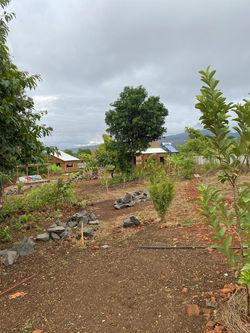 WhatsApp Image 2023-01-02 at 09.42.21 (6) |  WhatsApp Image 2023-01-02 at 09.42.19 (5) |  WhatsApp Image 2023-01-02 at 09.42.21 (2) |
 WhatsApp Image 2023-01-02 at 09.42.21 (3) |  WhatsApp Image 2023-01-02 at 09.42.19 (2) |  WhatsApp Image 2023-01-02 at 09.42.19 (1) |
 WhatsApp Image 2023-01-02 at 09.42.19 |  WhatsApp Image 2023-01-02 at 09.42.19 (7) |
Bhavantahapuram Farm, Markook
“During covid, I realized I grew up all these years not knowing or paying attention to the most important aspect of my life, food. The interest and inclination were always shallow. How is it grown? from where is it sourced? What are native foods we are aware of? What am I missing? ”, says our client Preeti. Her interest began when she came across the concept of permaculture. She wanted to attempt developing a small vegetable garden in the house they live. She started enjoying the process, her daughters began learning too. Her whole family is also invested in this journey and it gives them immense joy to grow and eat our own food.
Next Preeti was heading up to developing a food forest in the ancestral property of their native village. Her goal is to produce 90% of the food they eat as a family by growing them naturally. And to attain this goal, she approached us. It fascinated us with her interest in understanding the concept of permaculture in-deep, the native food, and sharing these practices within her community and making it a learning ground for future generations. We started with a 1.5-acre food forest and plantation of windbreak and live fence. It's been 6 months now and one could see life growing in the land.
 Bhavananthapur |  WhatsApp Image 2023-01-02 at 09.42.20 (1) |  WhatsApp Image 2023-01-02 at 09.42.20 (2) |
|---|---|---|
 WhatsApp Image 2023-01-02 at 09.42.20 (3) |  WhatsApp Image 2023-01-02 at 09.42.21 |  WhatsApp Image 2023-01-02 at 09.42.20 (4) |
 WhatsApp Image 2023-01-02 at 09.42.21 (1) |  photo1672632360 (4) |  photo1672632360 |
 photo1672632360 (1) |  photo1672632360 (2) |  IMG-20230519-WA0000 |
 IMG-20230519-WA0005 |  IMG-20230519-WA0003 |  IMG-20230519-WA0001 |
 IMG-20230519-WA0002 |
Theia Urban Foodscape, Hyderabad
A 350 yards plot amid Hyderabad city is not just turning green but bringing in diverse life forms. Our client Swati has been gardening and growing food for her family for a few years. She was enthused by learning natural farming methods. When Swati learned about Permaculture and Tribe, she approached us with the passion to develop her land and learn with us. Being lived in the city for years it was one of her dreams to create an Urban Food Forest model for the community. And by meeting Swati, her dream became ours too.
It was a small leveled piece of land where vegetables used to be grown. They wanted to increase production, good enough to support one family and bring in diversity. It was a square plot with fruit trees growing on the edges. We added more varieties of fruit trees and flower shrubs around, which could also serve as a windbreak. A Mandala design inspired vegetable garden was made in the center space and keyhole beds along pathways, creating more edges, more growing space & more productivity. Overhead trellis pathways and herbal spiral were also created to save space. We selected multifunctional perennial plants to grow that served human and wildlife needs. A bird bath garden was created on the corner to host the disappearing winged lives in cities. In the in-between spaces, compost pits were dug. A banana circle was also made for recycling greywater. Aiming at productivity, we never compromised on beautification. The first season harvest is here!! Have a look at the abundance from a small space garden.
 IMG_20221213_181938_296 |  IMG_20221227_205550_613 |  WhatsApp Image 2023-04-05 at 13.46.35 |
|---|---|---|
 IMG_20221207_190233_056 |  IMG-4225 | 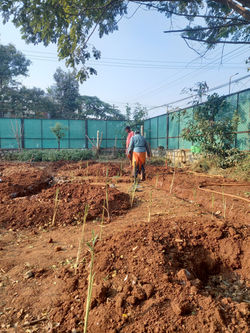 20221119_154436 |
 20221126_110456 |  20221126_160110 |  IMG_20221211_183810_705 |
 WhatsApp Image 2023-04-05 at 13.45.42 |  20221208_104944 |  WhatsApp Image 2023-04-05 at 13.46.35 (1) |
 IMG_20221210_103626_053 |  IMG_20221210_192753_188 |  IMG-20230429-WA0038 |
 IMG-20230429-WA0036 |  IMG-20230429-WA0037 |
Bageecha farm, Yelhanka
Located in the outskirts of Bangalore, amid real estate layouts, is a 1-acre Bageecha farm getting ready to be a haven for all life forms. Ruman and Fahad, having spent their childhood in Bangalore grew up observing how the city has been changing quite drastically from being a beautiful garden city with wonderful weather to an urban concrete jungle getting warmer by the day. It’s inspiring to see how couples influence each other for the betterment of the self and the society at large. Fahad with his strong ties to nature re-kindled the same in Ruman and slowly the curiosity and drive had led them to explore options for sustainable solutions. Ruman while doing her research stumbled upon permaculture and it seemed like a natural choice for the solutions it offers to their needs and challenges which led her to approach us.
The couple strongly desires to do something in their capacity to increase biodiversity, support native vegetation, live a life close to nature, increase food security, and make it a lively and educational space for children and adults to observe, learn and enjoy. Since the beginning of the project execution, we have observed more than 20 bird species in and around the farm because of the lakes nearby. If few trees on the property invite so many birds, Bageecha would be a refuge for hundreds of birds, bees, and butterflies in the coming future as the client desires to integrate as much diversity as the land can nourish and sustain other life forms. So far, we have included over 130 species of vegetation with various functions and hope to include more in the coming years. Besides productivity, this design specifically includes plenty of native flowering species for bees and butterflies. Earthworks and soil building were accomplished to harvest rainwater and improve soil life. A small pool was designed in a way that could also be used for irrigation purposes as the land requires a storage unit for irrigation.
 |  Zone.jpg |  |
|---|---|---|
 |  |  |
 |  | 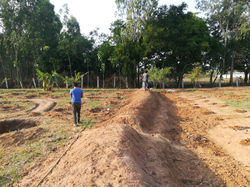 |
 |
Aranyani Farm, Anantapur
One simply doesn’t claim Penukonda as the 2nd driest district of India for no reason. If one wonders about the climate of Penukonda it goes from hot to sweltering hot to warm in a year – yes there are no cool breezy winters here! So, what do you do when you have 150 acres of land in the 2nd driest state of India? Well, Tribe had taken that challenge headlong and build a permaculture farm and even named it Aranyani (Means forest).
Climate was not the only challenge on this farm. The lime content in the soil was so high that trees that were 14 years old were dying. Animals from the wild hill range bordering the property like sloth bears, monkeys, wild boar, deer, and black napped hare would enter the farmlands and wreak havoc. It was quite interesting to watch saw sloth bears break the water pipelines to quench their thirst in the smelting hot summers. Dry weather and strong winds carried away what little topsoil was there left on the land.
The soil building alone took over a year as loads of banana mulch, manure, and carbon material were needed to cover the sprawling 150 acres of land. Windbreaks and fire breaks were integrated into the design as there is a big risk considering how hot and dry the region is. Tribe has accomplished digging about 5 ponds, 3 Percolation tanks, and several trenches on the site to address soil and water issues. The biggest pond of about half an acre in the wild zone collects all the harvested rainwater from the catchment area around the foothills of the mountain. This particular pond retains water round the year and in summers it served as a habitat for animals from the wild and restricted them to that zone which left the rest of the farmland to thrive.
Once the fungal network began to thrive on the land because of soil-building activities, Tribe was prepared to build nurseries, chicken coop, vegetable gardens, and food forests in the regenerated land. A self-operating chicken coop was established with all available local, and reusable materials for 400 chickens of 4 different breeds. This coop is designed in such a way that one can raise chickens with very minimal-no feed cost and generate high-quality compost as a bi-product. Aranyani had 80 acres of already established fruit orchards in which soil building and integration of supportive species was accomplished. Reforestation was achieved in 25 acres of land; fodder in 5 acres and vegetable garden in 1 acre is established. Now Aranyani stands as a proud host to 150 acres of biodiverse hub hosting more than 30 species of birds and diverse life forms.
 IMG20200604101935_edited.jpg |  1568743195131_edited.jpg |  1568743195131_edited.jpg |
|---|---|---|
 1570460302886_edited.jpg |  1570460302886_edited.jpg |  IMG20200602103441.jpg |
 IMG20200602091323.jpg | 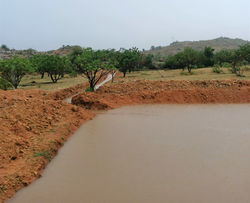 IMG20190917092%20_edited.jpg |  IMG20190917095224.jpg |
 IMG20200602083231.jpg |  IMG20190213145834.jpg |  IMG20190917113828.jpg |
 IMG20200107170133.jpg |  IMG20200318073345.jpg |  IMG20200508153150.jpg |
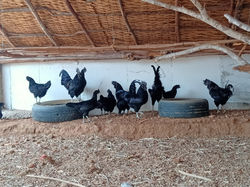 IMG20200410171007.jpg |  IMG20200429103734.jpg |  IMG20200413115138.jpg |
 IMG20191002075229.jpg |  IMG20190918125200.jpg |  IMG20190913105411.jpg |
 IMG20190724084450.jpg |  IMG20190215113125.jpg | 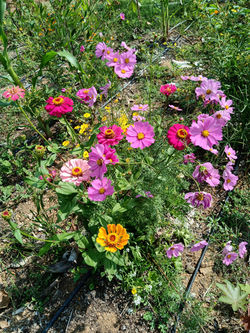 IMG20190202104841.jpg |
 IMG20190715165609.jpg |  IMG20190115114121.jpg |  IMG20190115114208.jpg |
 IMG20190103161615.jpg |  IMG_20200720_083116.jpg |  IMG-20190213-WA0023.jpg |
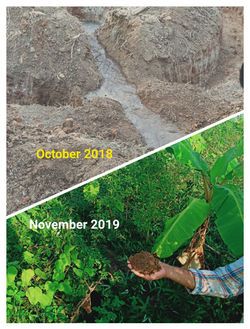 IMG_20200713_082843.jpg |  IMG_20190305_145251_849.jpg |  IMG_20181215_223625_189.jpg |
 IMG_20190305_102840_757.jpg |
Atharva Farm, Nasik
What would you think of hillside farmland that is next to a lake situated in the majestic Sahyadri mountain range of the western ghats – Breathtaking views? Amazing weather? Mesmerizing monsoon spells? Mountain breeze? Atharva farms was all that but something more – with a slope ranging from 5% to 90% - topsoil erosion was evident on the 2-acre farm due to the heavy winds and rainfall. The farm is located amid a conservation zone surrounded by mountain ranges with Anjaneri hills on their west. Three sides of the farm are shielded with hills with the only keyhole-like opening on the Northside of the farm bringing in heavy winds and creating havoc. As one can conceive how the land could be in hilly terrains, this farm too is sloped on the four sides with minimal accessibility and with two gullies on its east and west. When Tribe initiated the project in Atharva, there were only ornamental plants and a weak Mango orchard in dire need of soil nutrition, and the land was covered with invasive wild bushes like lantana. The goal was to set up a permaculture farm with a bread and breakfast place nestled in the heart of nature. And the solutions are just about observing and interacting and mimicking the ways of mother nature herself! To arrest the soil erosion due to rainwater, and to improve accessibility for growing food and maintenance, gabions and boomerang stone bunds were built to break the slope into smaller land terraces. These terraces also functioned as pathways along the slope and vegetation was added to stabilize it. Two ponds were dug which were fed by the rainwater harvested from the rooftop and catchment area. On the 2-acre land, Tribe had accommodated a vegetable garden, food forest, wild zone, windbreaks, fire breaks, banana circles for greywater harvesting, herb spiral, composting zones, living area, parking space, a campsite along the lake, and a viewing tower. Supportive species were planted in the existing Mango orchard to increase productivity and biodiversity. The project that started in November 2020 is slowly growing into the natural and rustic vision that’s held in place for the land.
 IMG20201016130938-01_edited.jpg |  IMG_20201102_104356-01.jpeg |  IMG_20201114_085901-01.jpeg |
|---|---|---|
 IMG_20201114_090036-01.jpeg |  IMG_20201114_090043-01.jpeg |  IMG-20210314-WA0007-01.jpeg |
 IMG_20201113_124142.jpg |  IMG_20201105_124703-01.jpeg |  IMG-20210314-WA0013-01.jpeg |
 IMG_20201112_154536.jpg |  IMG_20201025_082443-01.jpeg |  IMG_20201102_095519-01.jpeg |
 PicsArt_10-25-09.26.53-01.jpeg |
Ashwatth farm, Pune
This site located in Pune is one of the challenging sites where the farm is located in a valley with a heavy catchment above it, with a difference of 10 meters in Altitude from ridge to low point on site. Our clients Suruchi and Marthu Shanbagh, approached Tribe to design a self-sustainable food forest and to be able to live a life close to nature. It’s inspiring and rewarding when the clients particularly show interest in planting native varieties and trust the whole process.
It’s a 2-acre terraced property with black soil and heavy rainfall of 1500mm where rainwater runoff was eroding the topsoil and creating gullies. Though located in a valley, the farm is located in a recharge area, having less groundwater in its borewell due to the geological structure underneath.
Interdependence and collaboration are the secrets of resilience in the natural world. We are in no shortage of such opportunities if we truly look around. Such an opportunity arose when we started working on this site. Some of the major issues we had come across on the site were less water availability within the property, heavy floods during the rainy season eroding the topsoil and in addition, flooding the neighbor's residence. There’s a need for a solution that could resolve these issues and mutually benefit the client, the neighbor, and the ecosystem around. “Catch and store energy” is one of the key principles of permaculture. The pond with a capacity of 2,25,000 liters was built which paved the way for a multitude of opportunities and strengthened the relationships in the community. The neighbor came forward to help the client with water supply for the pond in the offseason, the local stoneworkers got an opportunity to utilize their skill to earn bread and butter for their families, flooding was controlled in the neighbor’s property, and a reservoir for the farm and household needs and lastly the bees, dragonflies, birds, and trees are happy to see a water body around to quench their thirst. In some cases, a pond could be an essential building block for a thriving community! We need more and more symbiotic relationships for the successful functioning of our societies. A percolation pit was also established at upper elevation (vesicular amygdaloidal basalt zone) in the property collecting a part of runoff from a gully (2nd or 3rd order stream) that flows along the border of the property. This facilitates groundwater recharge through the infiltration of surface runoff into the rock/soil benefitting the cultivable land below from the augmented groundwater. Stone pitching was done on one side to stabilize the soil where the runoff enters into the PT. Soil building was done and terraces were stabilized with vegetation.
 IMG_20210312_225721_784-01.jpeg |  Before after |  3 |
|---|---|---|
 IMG_4555 |  IMG_4553 |  IMG_4547 |
 photo1670994851 |  IMG_4505 |  IMG_4543 |
 IMG_4520 |  IMG_4499 |  IMG_4477 |
 IMG_4491 |  IMG_4488 |  IMG_4493 |
 6 |  5 |  IMG_20201210_130239-01.jpeg |
 IMG_20201222_111958-01.jpeg |  IMG_20201222_170651-01.jpeg |  IMG_20210110_104051-01.jpeg |
 IMG_20201216_160329-01.jpeg |  IMG_20210102_120110-01.jpeg |  IMG_20201222_170024-01.jpeg |
 IMG_20201215_112925-01.jpeg |  IMG_20210111_160226-01.jpeg |  Vegetable beds preparation |
 Established vegetation along the contour bund | 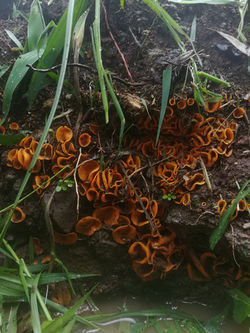 IMG_20210619_163734.jpg |  Established grasses along the slope to arrest erosion |
Sri Rangapuram, Wanaparthy
This project was nestled on the banks of Srirangapur Reservoir, in the foothills of Wanaparthy. But the land was extensively mined for Granite and was left with very little topsoil. Due to the clearance of forest growth, and being in the catchment area with a steep slope, all the rainwater running down the mountain ranges around caused heavy soil erosion and nutrient leech. Different types of soils ranging from silt, clay red, and rocky are present on the property. It's interesting how in some parts of the land, nutrients added to the soil would leech because of the high water table level, whereas, infiltration was an issue wherever the silt soils are present.
Before we got on board the client had tried to level the land except for a few places where they could not extract the granite boulders that were rooted deep into the earth. He carried out the 5-Layer farming model and planted a wide variety of trees but was struggling to sustain and grow them in these conditions.
The client initially approached us intending to do earthworks with the hope that it could support existing vegetation. Tribe had worked not on the earthworks alone but on building the soil life on the overall land including the contour trenches and made guilds by establishing supportive species as well. Earthworks were done to arrest soil erosion and divert the overflow into the lake.
Additionally, nursery, vegetable gardens (incl. mandala garden), pathways, food forest, seed saving systems, windbreaks, fire breaks, and live fences were also established to support and improve productivity.
 IMG_20200813_164649.jpg |  tribepermaculture_1-___CFPEsAHJ8eR___-.j |  tribepermaculture_2-___CFPEsAHJ8eR___-.j |
|---|---|---|
 IMG20200908124734.jpg |  IMG20200908172112.jpg |  IMG20200902172803.jpg |
 IMG20200911114946.jpg |  IMG20200912120345.jpg |  IMG_20200831_134614_791.jpg |
 IMG20200911145636.jpg |  IMG20200911115323.jpg | 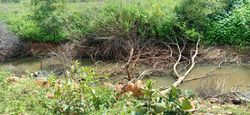 IMG20200905142449.jpg |
 IMG20200904123011.jpg |  IMG20200904171902.jpg |  IMG20200902120320.jpg |
 IMG20200829122407.jpg |  IMG20200829105356.jpg |  IMG20200829115705.jpg |
 20200924_123115.jpg |  IMG20200829095706.jpg |  IMG20200829095612.jpg |
 IMG20200824144456.jpg |  IMG20200828155402.jpg |  IMG20200825124645.jpg |
 IMG20200820112716.jpg |  IMG20200820100810.jpg |  IMG-20200819-WA0016.jpg |
 IMG20200805152343.jpg |  IMG20200816151724.jpg |  IMG-20200822-WA0018.jpg |
 IMG_20200825_162359.jpg |  IMG-20200809-WA0027.jpg |
Vruksha Farm, Anantapur
When this couple from Bangalore approached us with a vision to build a self-sustainable life on a quarter acre of land, Tribe was gladly on board to help create such a reality. But the challenge was to set up a permaculture farm with diverse elements in such a small acreage. The land was in a gated community with no permits to drill bore wells and the maximum water supply was 5000 liters per day. Moreover, the project was in the Kodikonda region at Ananthapur, the 2nd driest district in India. The quality of the soil was manageable to revive and grow but the water was alkaline.
A rainwater harvesting tank is set up on the property to solve the water crunch. Soil building methods were exercised to remediate the alkalinity of the water. Other elements that were accommodated in the design are a food forest, vegetable garden, herb spiral, house, parking, outhouse, view tower, nursery, ponds, rainwater harvesting tanks, stack functions on the fence, and a greywater system.
The project that started in January 2020 was already springing to life by September 2020 with plants and other life forms slowly adapting and adjusting to their new home!
 IMG_1498 |  IMG_1502 |  vruksha%20design_edited.jpg |
|---|---|---|
 IMG-20201026-WA0022.jpg |  IMG20210111135215.jpg |  IMG-20201026-WA0021.jpg |
 IMG20200108111715.jpg |  IMG20200108111615.jpg |  IMG_20200918_071357_945.jpg |
Proto Village, Anatapur
Protovillage, as some of you might already know, is a highly ambitious project initiated by Kalyan Akkipeddi, striving to build a fully functional prototype village demonstrating a resilient community life that breaks away from the paradigm of limitless economic growth and adopt a lifestyle that is more respectful of all life around us. When Protovillage wanted us to set up a permaculture farm for them in 1 acre, Tribe was gladly on board to collaborate with them. When we find a client, who understands the ethics and the principles of permaculture, and who is aligned with our values, we consider half our work done. Kalyan is enthusiastic to consider permanent sustainable solutions instead of quick, immediate fixes. The project was located in Anantapur - for those of you who have read all our posts - you would know that it is the 2nd driest district in India. Therefore, water scarcity was a huge issue. Additionally, there was very little topsoil and the climate being dry and windy we had to stop wind erosion. Earthworks for rainwater harvesting and soil building were accomplished. Sunken beds were prepared to reduce water usage, prevent wind erosion and establish a microclimate. Windbreaks were planted around vegetable beds and food forest to further decrease wind erosion.
 IMG20200315092755.jpg |  IMG20200314083612.jpg |  IMG-20200906-WA0012_edited.jpg |
|---|---|---|
 IMG-20200906-WA0013_edited.jpg |  IMG-20200906-WA0016_edited.jpg |  IMG20200316130745_edited_edited.jpg |
 IMG20200315093700_edited.jpg |  IMG-20200907-WA0002_edited.jpg |  IMG20200314090839.jpg |
 IMG20191213122833.jpg |  IMG-20200907-WA0005.jpg |  20200130_084955.jpg |
JC farm, Narayanpet
What do you think of land close to a river? Rich? Dense vegetation? Fertile soil? Abundant water to feed the plants? Ever heard of a gully though? Well, Gully is a trench, a narrow channel which was worn by running water, eroding sharply into the soil. JC Farms was on such land, 20 acres situated in an area that used to be a gully of the Kondapally river, with silt and white sand soil and wild thorny bushes and few pioneer trees like Senna Auriculata and Acacia Nilotica. Since the land used to be a gully it floods whenever it rains. 1 acre which was slightly elevated from the rest of the land with some clay content in the soil was chosen and initiated with soil building, growing millet, and pigeon pea, establishing vegetable beds, building a house, nursery, and cattle shed. One must wonder why this unconventional approach of building zone zero upfront, instead of setting up the food forest and the wild zone first. This is where one of the key principles of permaculture “Use small and simple solutions” plays a role here. Since the soil condition was very challenging and it required resources in bulk volume to initiate the soil building, making small, incremental changes seemed to be the best way to move towards sustainable change which means generating resources within the land rather than getting inputs from elsewhere. Therefore, growing annuals to generate carbon material and integrating animals for manure and urine, establishing a nursery where saplings are accustomed to the existing conditions seemed like a sensible choice in the given context. A house was built as an integration of annuals, a nursery, and a cowshed needed constant human nurturing. To irrigate this initial set up a borewell was dug up and fortunately, water was present in abundance at a depth of 120 feet. Once this system was established, earthworks for the rest of the land were initiated with trenches and 4 ponds. Reforestation was done using the Miyawaki technique. By the time the soil building for 5 acres of the land and reforestation of about 1 acre was done, the client started engaging in the process, did a permaculture design course himself, and took over the project from the Tribe. To inspire the client to be so invested in the process was the most rewarding experience for the tribe and we knew our challenging project was in good hands!
 IMG20190217161549.jpg |  IMG_20200723_081512.jpg |  IMG-20190728-WA0005.jpg |
|---|---|---|
 IMG_20200722_203255.jpg |  IMG-20190703-WA0006_edited.jpg |
Vemasa Farm, Nellore
The love for gardening and growing food is passed on as a legacy in some families. Few are those fortunate children who grow up watching their elders tending to other forms of life and watching them grow along with them. This paves a way for an unspoken bond with nature. We care for something we love. As simple as that! This seed of inspiration from her childhood led our client Deepa to desire a better planet for the future generation. She started to explore ways and saw permaculture as a holistic means to bring her vision alive. Deepa approached us with a vision to provide food security for her family and to create and sustain a place for future generations to be able to live close to nature. It was a rather easy task as she was very passionate and invested in the whole process of designing, and executing learning all along the way. Passion is contagious and it's very evident as her children love visiting the farm more than going to school-A legacy in the making.
The plan is to establish a self-sustaining food forest on 1.7 acres addressing their needs and challenges associated with the land. It’s a 1.7-acre bit of the total 4 acres farm located 24km away from Nellore, in a village called Palicherlapadu surrounded by chemical-intensive agricultural farms. The clients eventually plan to move to the farm but currently, caretakers live on the remaining 4-acre property. As a result, taking into account the future needs and challenges, the land is designed considering two zone-zero’s. It’s relatively flat land with a slope of less than 5% and an average rainfall of 1000mm with the regular occurrence of cyclones as it is situated in a coastal area. Soil type is Red loam layer up to one foot, followed by clay layer up to 2 feet, and granite as bedrock. Tribe had executed earthworks for soil building and rainwater harvesting, along with chicken and duck coop, nursery, shallow ponds, windbreaks, and a live fence which could serve as pollution break, vision break, and fire breaks. A vegetable garden with mandala along with trellis, herbal garden, and butterfly garden is established on 0.25 acres. The chicken coop is designed in such a way that it is self-operating and nutrients are recycled so that there’s no-less feed cost and compost is generated which in turn can be used in the vegetable gardens.
 IMG_20210325_081211-01.jpeg |  IMG_20210119_095625-01.jpegBefore |  IMG_20210324_104447-01.jpeg |
|---|
